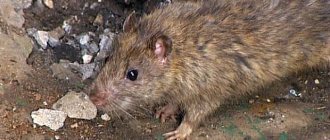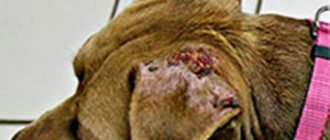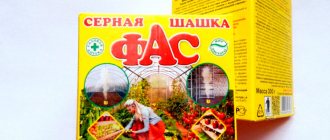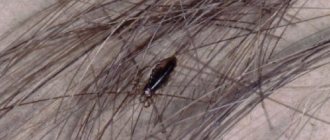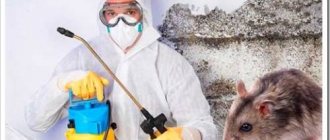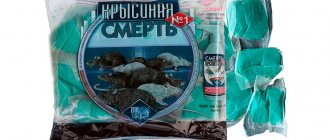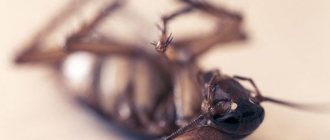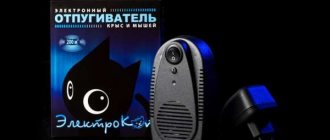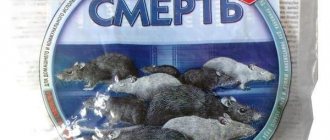Types of rat poison and mechanism of action on the human body
Rat poison is a general name for a fairly large number of different toxic substances, differing in mechanism, speed and degree of effect on the body.
All poisons can be divided into several groups:
- Arsenic, lead, yellow and white phosphorus. This category includes highly toxic drugs, the use of which is prohibited due to the high degree of danger to people and animals. For poisoning, it is enough for the substance to come into contact with mucous membranes or damaged skin. You can become poisoned by inhaling toxic particles.
- Ratside, zinc phosphide. These drugs are also toxic and pose a health risk. They are used only when other means are ineffective.
- Zoocoumarins. These drugs are based on substances that thin the blood. Once in the body, they provoke intense internal bleeding, which causes the rodents to die.
Poison
There are two types of zoocoumarins:
- 1st generation (Warfarin, Ratindan, Izoindan) – the effect does not begin immediately, toxic substances are quickly eliminated from the body with urine and feces (in addition, rats develop immunity to such drugs over time);
- 2 generations (Flocumafen, Difenacoum, Bromadiolone) - accumulate in the body, have a faster and more powerful effect.
Rat poison affects humans in much the same way as it does rats. The difference is that a person needs a much larger dose, but even in small quantities the poison can be dangerous to health. Especially when it comes to young children or weakened people with chronic diseases.
Antidote for mouse poison for humans
Specific antidotes for drugs of the anticoagulant group include synthetic derivatives of vitamin K: phytomenadione, vikasol. Zoocoumarins increase bleeding by disrupting the synthesis of vitamin K, which ensures normal blood clotting. To compensate for its deficiency, vikasol or phytomenadione are administered by injection - intravenously, intramuscularly or subcutaneously. Tablet forms are not used to treat poisoning due to lack of effectiveness. Vikasol is only allowed to be injected into a muscle; phytomenadione is sometimes given into a vein.
Important!
Phytomenadione should be administered intravenously very slowly due to the high risk of developing an allergic reaction.
The course of treatment with antidotes continues for 2 weeks. During this time, the poison is completely removed from the body, and the natural synthesis of vitamins is restored. During outpatient follow-up treatment, it is sometimes recommended to take Vikasol tablets.
How can poisoning occur?
Poisoning with rat poison is possible in any place where rodent baiting activities are carried out. Most often, poison enters the human body accidentally:
- during breathing;
- in case of contact with the skin (especially if there is damage to it - wounds, abrasions, scratches);
- with food.
You can get poisoned, for example, in a cafe if you drink or eat something from a dish on which particles of poison remain after rats were poisoned in the room. Rat poison can get on food during rodent baiting in a warehouse, production workshop, or store.
Small children are in a high-risk area. Babies are inquisitive and put everything in their mouths that comes into their hands. This item may be a poison pill.
In the past, when highly toxic drugs were used for baiting, a small dose was enough to cause serious, sometimes fatal, toxicity. But it’s quite difficult to achieve this with modern drugs for baiting rats. The lethal dose of zoocoumarin for an adult is about 150 g of pure substance. Considering that in purchased poisons the concentration of the active substance is about 2-3%, for serious poisoning you need to eat several full packages or regularly use rat poison.
Chilibukha - both medicine and rat poison
Those who like to solve crossword puzzles have probably come across the question more than once - poison from chilibuha 6 letters. Answer strychnine
Scientists in Europe learned about the unique medicinal properties of chilibukha only at the beginning of the 19th century, when they were first able to isolate strychnine from this plant. While on the other side of the planet, in South America, the Indians, several centuries earlier, had successfully used curare poison in hunting and internecine wars.
The conquistadors who visited the American continent in the 14th century were quite surprised by how the local population calmly consumed the meat of animals killed by poisoned curare arrows without any negative consequences for health. It turned out that this powerful poison, when it enters the body through the digestive tract, loses its destructive properties, but biologists and chemists learned about this only over time.
Biological description
Chilibuha (the second common name is vomit nut), for such a formidable, even deadly plant, looks quite cute.
Tall, spreading deciduous tree of the Loganiaceae family. Some adult specimens grow up to 15 m. The trunk is strongly curved, young trees have sharp and long spines. The natural habitat is the subtropical zone. The plant is found in large quantities in southern Asia, India and Australia. There is information about attempts to cultivate chilibuha in Africa.
The leaves of the chilibuha are opposite, short-petioled, oval in shape. The plate is smooth, with a sharp apex, with several distinct veins. The flowers are inconspicuous. Small, indefinite, pale light green color. They are driven out by semi-umbrella inflorescences in the axils of the upper leaves. Flowering period: March-May.
The fruits are large, round, and berry-shaped. With translucent colorless-grayish pulp inside, and a hard, orange, sometimes reddish, peel. Fruiting period: from May to August. Harvest period: October to November.
For humans, the seeds of this plant are of greatest value. Hard, flattened, disc-shaped, with small, translucent, whitish hairs. On average, one fruit contains from 2 to 7 seeds.
Chemical composition
The amount of alkaloids in chilibuha seeds is 2-3%. The majority of the percentage is occupied by 2 substances - strychnine and brucine, the share of other alkaloids is no more than 0.1%. Also found in the seeds: olein, mannan, chlorogenic acid, glycoside, galactan, etc.
Properties
Brucine has found its application in chemistry and is used as a reagent. Basically, the plant, or rather only its seeds, are used in pharmacology and medicine. The strychnine they contain is a powerful stimulant for the body. The spinal cord and medulla oblongata demonstrate particular sensitivity to it.
Even a one-time dose of strychnine activates metabolic processes in the body, increases blood pressure, constricts blood vessels, and quickens breathing. After taking this substance in microscopic doses, there is a sharp increase in visual acuity and an expansion of the field of vision, hearing improves by several orders of magnitude, and the sense of smell becomes more acute.
Previously used as a means of deratization (extermination of rats, mice, etc.)
Application
In medicine, strychnine is used as a stimulant. Often, in the treatment of the consequences of paralysis, paresis, pathologies of the auditory and visual areas.
Strychnine is also prescribed for decreased metabolic processes, lethargy, rapid and severe fatigue, when symptoms of hypotension appear, weakened heart function due to various types of intoxications, infectious diseases, as a tonic and restorative.
For children under 2 years of age, the substance is strictly contraindicated and is never prescribed for medicinal or other purposes.
Uncontrolled use of chilibukha-based drugs is strictly prohibited.
The information on the site is provided solely for informational and informational purposes, does not claim to be reference or medical accuracy, and is not a guide to action. Do not self-medicate. Be sure to consult a specialist.
The first signs of intoxication
Signs of rat poison poisoning and the timing of their appearance depend on what particular substance has entered the body and in what quantity. In the case of highly toxic poisons, symptoms appear within a few hours. The consequences of consuming zoocoumarins appear after 2–3 days (if the dose was large, deterioration in health may occur faster).
The first signs of intoxication:
- general malaise;
- weakness;
- Strong headache;
- nausea;
- decreased appetite;
- joint and muscle pain;
- nose bleed;
- bleeding gums.
Bleeding gums
If a small amount of poison enters the body, the symptoms will subside within 1-2 days. Sometimes a person does not even understand what caused the sudden illness.
Substance intoxication
How does bait act on the human body? To die from rat poisons, you need to try, because, despite their toxicity, the concentrations are designed for rodents. Therefore, the concentration necessary for human intoxication can accumulate as a result of periodic use or a large single dose of a pure substance. In addition, edible products are added to the bait: meat, bread crumbs, so the content of pure poison will further decrease. Be that as it may, you should not expect health benefits from taking such drugs.
Poisoning with rat poison in humans has the following symptoms:
- Bleeding from the nose, gums, when urinating - poisons for animals affect blood clotting and block the production of vitamin K.
- Dizziness (the more the drug was taken, the stronger it is).
- The victim looks weak and tired.
- Nausea, lack of appetite.
- Paleness of the skin.
- Slowness of body movements and reactions to external stimuli.
- Less commonly - diarrhea, abdominal pain, red spots on the skin.
First aid
As soon as symptoms of rat poison poisoning appear in a person, you need to immediately go to the hospital. Before the ambulance arrives, the necessary assistance must be provided. But there is no need to panic, because composure and responsibility are indispensable companions to successful assistance. A panicking person can, on the contrary, harm the victim.
Actions in case of danger
When it became clear that this was poisoning, there was no time to hesitate. You should take action immediately. Of course, you need to call an ambulance, but you can also help someone who has been poisoned.
- Use a large amount of water (at least three liters or one liter of salted water) to provoke vomiting in the victim.
- Give activated carbon (any other sorbents) in a dosage suitable for a certain body weight.
- Use laxatives to quickly remove poison from the body.
- The patient needs to stop eating and sleeping for a while.
Read also Sarin - a chemical weapon of mass destruction
If toxic substances come into contact with the skin, they must be washed immediately under running water and soap. The eyes and mouth also need to be washed.
Consequences of poisoning
Long-term harm to health can be avoided if you help the poisoned person in time and consult a doctor. If the damage to the body from the poison is high, then in the future you will experience negative consequences of this intake:
- Bleeding gums.
- Internal hemorrhages.
- Heavy and continuous blood loss even with minor wounds.
- Disorders of the liver and kidneys.
Further symptoms of poisoning
In case of severe poisoning with rat poison, the following symptoms are gradually added to the primary symptoms:
- lethargy, drowsiness, lethargy;
- dizziness;
- vomit;
- movement coordination disorder;
- dyspnea;
- cardiopalmus;
- blurred vision;
- hearing loss, constant tinnitus;
- uterine, gastrointestinal bleeding;
- diarrhea with blood clots, blood in the urine.
If a lethal dose of rat poison is taken, a person’s condition quickly deteriorates, metabolic processes are disrupted, the blood formula changes, and the walls of blood vessels are destroyed.
People with kidney and liver diseases suffer the most from rat poisoning, since these organs are responsible for neutralizing and removing toxins from the body.
How to prevent poisoning
If you fight gray rats and mice on your own, follow the safety rules. Be sure to wash your hands after performing work, or better yet, use disposable protective equipment. If you have small children in your apartment or house, try to protect them from the poison.
When choosing a means for deratization of a living space, it is recommended to use drugs with a weak toxic effect. Don't forget to consider alternative rodent control options. Perhaps you should just get a cat?
Giving help
A person poisoned by rat poison needs medical attention. As soon as the fact of using a toxic substance has been discovered, you should call a doctor, since it is unknown how much poison has entered the body and what the reaction will be. Before it appears, it is necessary to provide first aid to the victim.
First aid
In case of poisoning by rat poison, timely provision of first aid to a person helps to slow down the spread of toxins throughout the body, prevent the development of severe consequences and alleviate the condition of the victim.
Mandatory activities:
- cleanse the stomach - you need to drink 1–1.5 liters of water with salt, then induce vomiting (the procedure is repeated until the person begins to vomit with clean water);
- cleanse the intestines - an enema is used for this;
- taking sorbents (activated carbon, Enterosgel, Polysorb) - will help reduce the concentration of toxins in the body;
- if the poison gets on the skin, it must be thoroughly rinsed with clean water, paying special attention to wounds and abrasions.
During the process of vomiting, the body loses a lot of fluid. To restore balance, a person must drink a lot (small portions, but often). Pure water or weak tea will do.
Hospital treatment
In case of severe intoxication, treatment is carried out in a hospital setting. The treatment regimen may include:
- gastric and intestinal lavage;
- droppers with detoxification solutions;
- vitamin K injections;
- hepatoprotectors that normalize liver function.
Under a drip
Sometimes plasmaphoresis (hardware blood purification) is prescribed. In case of intense bleeding, a blood transfusion is performed.
Clinical picture of intoxication and treatment
With small doses of poison (0.005–0.01 g), the symptoms of strychnine poisoning are as follows:
- severe anxiety;
- a feeling of stiffness and tightening of the neck and chewing muscles;
- difficulty swallowing;
- muscle tremors;
- increased sensitivity to stimuli (light, sound, touch, etc.);
- difficulty breathing.
When 0.03 g or more of strychnine enters the body, the following symptoms are observed:
- tetanic convulsions in response to the slightest irritation;
- oppressive feeling of fear;
- photopsia - the appearance of bright flashes before the eyes;
- clouding of consciousness;
- involuntary urination and defecation;
- strong contractions of the muscles of the face, arms, and respiratory muscles.
Such symptoms occur in the form of short-term attacks lasting about one minute. Then the muscles relax and breathing is restored. The next paroxysm occurs after 15–20 minutes. Gradually, the duration of seizures increases, and the periods between them decrease. If emergency assistance is not provided, central nervous system paralysis and death occur.
Strychnine poisoning is often accompanied by seizures
In addition to the specific symptoms characteristic of the action of the toxin, poisoning is accompanied by general symptoms:
- increase in blood pressure;
- tachycardia;
- temperature increase;
- acute chest pain;
- nausea, vomiting.
After the first signs of poisoning appear, the victim must be placed in a comfortable position, restrictive clothing removed and absolute rest ensured, eliminating even the slightest external irritants. Gastric lavage is recommended, but only if there are no convulsions, otherwise aspiration of vomit is possible. The victim should be given a saline laxative and enterosorbents (amount according to instructions).
Strychnine intoxication is deadly. Therefore, the victim should be immediately taken to the toxicology department, where he will be given adequate treatment. Tranquilizers, barbiturates or muscle relaxants are used as an antidote. Another antidote for strychnine is curare-like compounds.
Consequences of human poisoning with rat poison
Consumption of rat poison quite rarely leads to the death of the victim, but the negative consequences of poisoning can manifest themselves for a long time, and in the worst case, accompany the person for the rest of his life. The most common complications:
- inflammatory diseases of the digestive system (pancreatitis, cholecystitis);
- renal failure;
- liver failure;
- toxic hepatitis;
- hemophilia.
Problems with blood clotting can manifest themselves in frequent nosebleeds, bleeding gums, and excessive bleeding even in the case of small wounds on the skin. Internal bleeding is also possible.
How to properly poison rats
There is a large amount of specialized literature on this topic, aimed at large enterprises and describing literally everything: types of poisons, features of their use, methods of use, quantities, time intervals and much more.
However, for small scales everything is much simpler.
It is enough to place the anti-rat agent in places where rat paths pass, near burrows, in feeding areas, etc.
After a few days (the exact time is indicated in the instructions for the product), the rats that ate the bait will die.
After this, the procedure should be repeated. After exterminating the rats, you need to seal the holes through which they enter the territory.
It is not recommended to constantly lay out bait, since over time the rats' resistance to poison increases.
Poison is a toxic substance, so some precautions should be taken when using such substances.
Place rat poison out of the reach of children and pets.
Remove all food products from the area where the poison is located.
Learn first aid measures in case of poisoning.
The rat carcasses must be collected and discarded.
If you own pets, keep in mind that they can eat the corpses of rats that still have poison in them. It is best to bury the corpses at a safe depth.
If dead rats are left indoors, they will begin to decompose, resulting in a corpse-like odor, and may also lead to disease transmission.
Now you know how to poison these small rodents, the main types of means, as well as the rules for their use. We hope this information is useful to you.
Pesticides for pest control
Today, anticoagulant-based rodent poisons are the most effective. Among such drugs, substances of the 1st and 2nd generation are distinguished. Their difference is that 1st generation poisons accumulate in the animal’s body gradually as it is eaten, so death occurs more slowly.
2nd generation drugs include:
- Storm is a rat control agent based on flocumafen in briquettes, a modern effective poison. Its analogue is Goliath, which is sold in 1 kg packages for use in large rooms. Rats begin to die 3-4 days after ingestion; in almost 7-10 days the entire colony is eliminated.
- Nutcracker, Brodifacoum, Krysin, Mortorat contain brodifacoum.
- Efa, Rattidion, Clean House - the active toxic substance bromadiolone helps to poison rats.
- Tsunami-Extra, Ratol - preparations with difenacoum.
- Down with uninvited guests - a set consisting of bags of poison containing a complex of active substances: bromine paste, rattidione, brodirate, etc. Cheese, vanilla and ham smells are added for bait. The kit includes a bait house and protective gloves, the price is about 400 rubles.
Poison for rats and mice is sold in hardware or gardening stores, and it is also possible to purchase it online.
However, the products that are sold under the guise of “mummifying” are for the most part quite effective rat poisons, specifically designed to kill rodents and cope well with this task. Rats and mice die after eating them, and for the reasons stated above, the use of these products does not usually result in a decomposing odor in the premises. Although such preparations do not guarantee the absence of odor in the room, they are quite capable of killing a rat.
We suggest you read: How and with what you can poison rats: effective poisons and poisons
Therefore, Storm, Nutcracker, and all other products based on blood anticoagulants can be safely used in accordance with the instructions. They are laid out in those places in the room where rats and mice are most often, and new portions are added as the old ones are eaten by pests. Typically, rats die 3-4 days after they feed on such bait for the first time (sometimes, depending on the amount of poison eaten, the effect occurs earlier or later).
It is important to remember that most rat poisons are very toxic to pets and humans. Cats are especially sensitive to them. Therefore, baits are placed where pets cannot find them, ideally in special containers that only rats or mice can get into.
So you can get rid of rats and mice in the house, so as not to suffer from cadaveric gases, in other ways. The best of them are mousetraps or rat traps, both crushers and those that catch animals alive.
After charging and installation, such a device should be checked regularly, and caught or killed animals should be removed from the apartment as far as possible. In this case, they definitely won’t stink up the room.
Also, many cats and some burrowing dogs - fox terriers and Jagd terriers - successfully catch rats and mice. They certainly won’t let their prey go to waste, although after a successful hunt and meal, pets may leave unaesthetic rodent paws or tails in the apartment.
You can’t just use poison at the same time and count on such helpers in the fight against rodents: even if a cat or dog doesn’t find poison, it can catch and eat a poisoned, but not yet dead rat, and poison itself. Therefore, for safety, you should first let a pet rat catcher into the room for 2-3 days, and if he can’t cope, then remove him and set traps or spread poison.
If you have personal experience with the use of “mummifying” poisons when fighting rats or mice, be sure to leave your review at the bottom of this page (in the comments field).
Before finding out how the poison for rats and mice works, you need to determine which group the product used belongs to. Accordingly, both the composition and the price will vary. Thus, acute poisons include zinc phosphide or rodenticides. As a rule, they are sold not in tablets, but in the form of an aerosol.
This also includes zoocoumarin - it is low-toxic when administered once, but when accumulated in the body it causes poisoning and death from hemorrhage.
It should be remembered that an effective poison for mice and rats will always be potentially dangerous to humans. Therefore, before you buy poison for rodents (rats and mice) and start using it, you should always worry about your own safety measures - especially regarding compliance with the recommended dosage. So, on what basis can there be poison for mice and rats:
- warfarin granules: has an effect on the circulatory system,
- zinc phosphide: directly affects all major organs and the respiratory system,
- arsenic compounds: cause depression of the nervous system and prolonged pain. In high concentrations they are extremely dangerous for humans,
- Thallium and lead compounds have an incredibly high degree of toxicity and can therefore also pose a threat to human life,
- white or yellow phosphorus: causes damage to all bone tissue, including bone marrow,
- Strychnine as a poisonous substance is even included in the state register.
As an alternative means, repellers can be used - regardless of the number of harmful rodents.
How to avoid poisoning?
In order not to be poisoned by rat poison, and also not to endanger the health of other people, certain rules should be followed when working with toxic drugs:
- When preparing and laying out the poison, you must wear gloves and a mask;
- after finishing working with poison, you must change clothes (send your clothes to the wash), wash your hands and face thoroughly;
- store the poison in tightly closed packaging in a place inaccessible to children and pets;
- prevent contact of toxic substances with food and utensils;
- Before you start baiting rats, warn your household (if the poison is used in public places, an announcement about this should be posted).
It is not recommended to use rat poison in residential areas, as rats can spread particles of the toxic substance throughout the house, leaving them on the surface of tables, dishes, and food.
How to get rid of rats without poison
Finally, you can get rid of rats without poison, and often such a fight can be even more effective than using poisons.
So, as an alternative to poisons, you can use:
- Traps (as a rule, ordinary rat traps and crushers are used). They are good because one trap can catch tens and hundreds of rats, if necessary, without any additional financial costs. However, traps have their drawbacks: they are more troublesome to use than poison, and pose some danger to children and pets (in particular, a rat trap can easily break a cat's paw). But, perhaps, the most unpleasant thing is that you will have to regularly remove an animal with crushed bones, and sometimes fluttering, from the rat trap;
- Live traps are completely safe, but they are just as effective as traps. Their main disadvantage is the need to do something with a caught rat - either kill it, or take it far outside the premises and release it. It's troublesome. On the other hand, you can make live traps with your own hands, sometimes it’s faster, more effective and even easier than buying poison or industrially produced traps;
- Another option is a cat or rat-catcher, you can borrow it from neighbors or relatives and lock it in a room with rats. Often this particular method of fighting rats turns out to be simpler and more effective than all others;
- Electronic rat repellers - in some cases, they actually help repel rodents. But the disadvantage of such devices is that you can never know in advance whether the device will work against rats in a particular house or not. At the same time, repellers are quite expensive and, in addition, not only rodents, but also pets can react sharply to them.
However, poisons are good because, with the right approach, they allow you to poison a large (sometimes huge) number of rats in a short period of time and with minimal labor costs. If you take into account the peculiarities of using poisoned baits, you can use them to get rid of pests in almost any room.
An interesting video describing an original method of getting rid of rats and mice in the house
- About mummifying poisons for rats and mice and the nuances of how these products work
- Poison from rats and mice Goliath and features of the use of this remedy
- Poison for rats and mice Storm (manufactured by BASF) and reviews of its use

